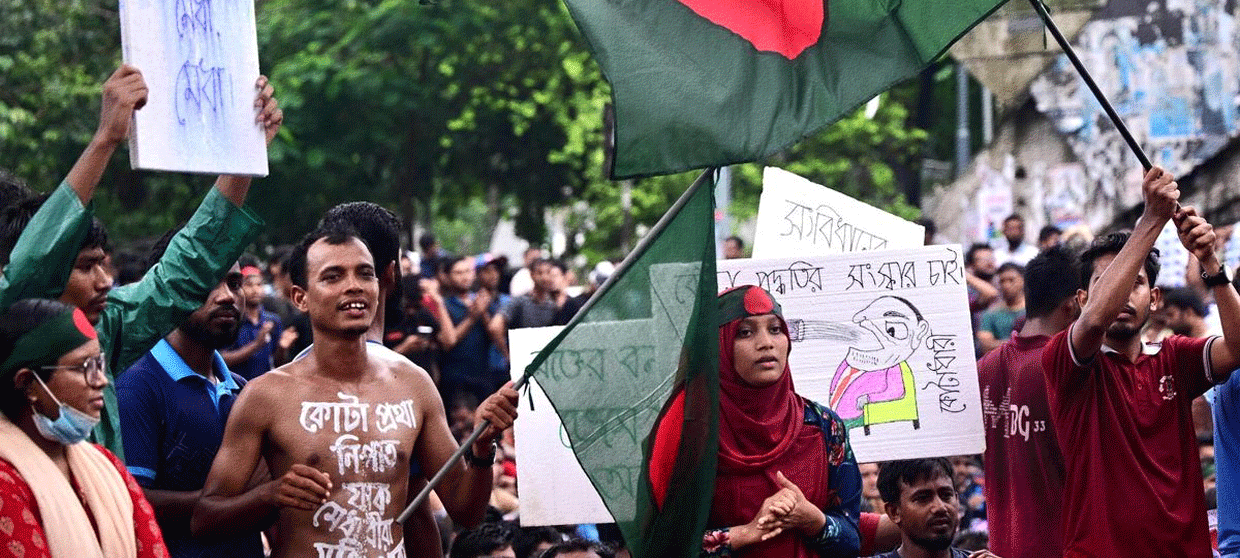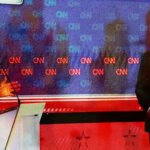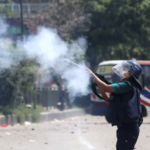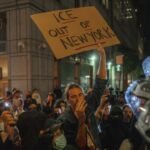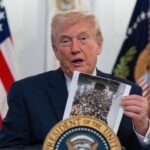
by Dr. Dilip Nath
The quota movement in Bangladesh has developed from a students demand for change of policy to political crisis involving violence and demand for removal of Prime Minister Sheikh Hasina. This overview will also discuss the background of the movement, consequences, state of affairs, and politics of the scenario especially the BNP and Jamaat-e-Islami’s role. Also, it will give background information about Sheikh Hasina’s government and her achievement and at the same time arguing other movement.
Background of the Quota Movement
The quota system of civil service jobs in Bangladesh was first introduced when the government wanted to provide a share of the civil service jobs to the reserved groups. But in recent years, it turned to be debated one due to the opinion that quotas are abused; thus, change is welcomed. It gained support from students specifically targeting CEOs who wanted to eliminate or at least lower the quotas as they considered merit as the best reason to be recruited.
How the Quota Movement Started
The appreciation of the quota reform movement started in the year 2018 when the students’ formed groups to demonstrate against the existing quota systems arguing that it was a demerit of meritocracy. The demonstrations were taken to the next level following the government move in March 2018 to scrap the less favorable quotas. At first, the students’ claims were related to the need to change the quota system only for the benefit of providing equal opportunities for the representatives of the weaker sections of society.
Implications of the Movement
What the men themselves have done to the ‘quota movement’ is not to be underestimated. Not only has it focused on merit in civil service in Bangladesh, it has also revealed the society’s prejudices in representation and discrimination. The protests have brought necessary focus on the fact that merit needs to be combined with social justice to minorities.
Current Status
Beginning of July 2024 sees a drastic change in the circumstances whereby; The Appellate Division of the Supreme Court has come up with a ruling for that 7% affirmative action for certain liberate groups such as the freedom fighters and the ethnic groups but opens up 93% for competition. This ruling was considered as the prospective solution to the protests, which still matched the students’ demands. However, the movement has a problem of violence with unrests which have more political factions leading to rampage and arson in various regions of the country.
Some open sources state that during July 18-21, intensive fighting took place, and calculated for each of these days the loss in terms of lives of between 30 to 51 people in Dhaka and other cities. There were allegations by medical facilities of the use of live bullets on protesters further demonstrating the regime’s willingness to deal with the protests violently. The violence has received global concern, diaspora groups’ protests in other nations demanding Hasina’s ouster.
Political Hijacking of the Movement
The quota movement has been hijacked by the party opposition Bangladesh Nationalist Party (BNP) and Jamaat-e-Islami whose … main agenda are anti-Prime Minister Sheikh Hasina, not the students’. This has led to use of force which includes; fighting, destruction of property and a general degradation of the law and order. Several accounts show that these political groups used students’ genuine concerns to advance their causes; thus the non-violent protests end up being a pathway through which political opposition to Hasina’s government is waged.
The BNP and Jamaat have been caught in the middle of charges of inciting violence and the protests serve as a tool to overthrow the government. The situation has been so progressed that now armed cadres of these parties have started controlling the protest which often results in the burning of public and private property. The country has been put under a curfew and the military deployed to quell the violence.
Even in Dhaka city, Vandalism and arson attacks have targeted and affected various Government buildings including BTV Center, National Data Center, Bridge Authority Building and many others that include the Disaster Management Authority Building, BRTA Building, Mirpur Indoor Stadium, Building of the Postal Authority, at least two Metro Rail Stations, a number of toll plazas of the Elevated Expressway, BEZA Bhaban, DG Health Office, a number It is important to note that no one and nothing was safe during this unprecendented campaign of violence, not even private properties and transports. There were also testimonies about violence from other parts of Bangladesh, apart from Dhaka. In the specific districts which include Rangpur, Narayanganj, Madaripur and some others, several installations belonging to the Law Enforcement Agencies have been attacked paralyzing several security personnel while leaving several grievously injured and several others having their arms and ammunitions stolen. In one daring attempt, many hundreds of the prisoners, two of whom where Jihadist convicted terrorists, broke out of the district jail of Narshingdi, leading to the theft of the jail’s arsenal, and the degradation of the residents’ property, quarter of the jail authorities.
Sheikh Hasina and Her Government
Bangladesh has witnessed Sheikh Hasina as a key political personality right from the time when she came into power for the first time in 1996. It has been her government that has seen relatively high economic growth, infrastructural development and the overall advancement in social facilities such as education and health. She has also strived in women’s rights, poverty and income inequality where her administration has achieved tremendous milestones and she has been recognized internationally.
Nevertheless, the government led by this woman is criticized for suppressing dissent and opposing it. Today’s quota movement, however much it had its inception on perfectly valid grounds, has been painted by some as a wrecking ball, designed to bring her government down rather than make constructive changes. The last disturbances have illuminated the weak points of the government and its illegitimacy, especially as the basic storyline changes from the non-educated population of Yemen to the intellectuals who are now quite actively protesting the actions of the administration
Conclusion
The necessary understanding of the interdependence between grass root student movements and political strategies could be observed while analysing the recent quota movement of Bangladesh. In my opinion the earlier part of the demonstrations regarding reform was justifiable, however those following the physical aggression and taking advantage politically have gone too far. In conclusion, the Awami League government under the leadership of Sheikh Hasina has done well in these developments besides managing to address some of these crises when coming to power; however, the new regime is one that must attend to these problems while rebuilding and ensuring students’ voice is not hijacked by politically augmented unions. The result of this fighting was expected to redefine the country’s politics, economy, as well as its societal structure in the next several years and possibly beyond.
References
AL-ZAMAN, M. S. (2019). DIGITAL DISINFORMATION AND COMMUNALISM IN BANGLADESH.
FERDOUS, A., & HUDA, Z. (2023). SOCIAL MEDIA, NEW CULTURES, AND NEW THREATS: IMPACT ON UNIVERSITY STUDENTS IN BANGLADESH. HUMAN BEHAVIOR AND EMERGING TECHNOLOGIES, 2023(1), 2205861.
Hassan, Z. (2024). Is This the Beginning of the End of Sheikh Hasina’s Rule?
PRESSXPRESS.PX. (2024). QUOTA REFORM: CONSPIRACY BEHIND A MOVEMENT.
RAHMAN, T., & JAHAN, I. (2020). THE ROLE OF SOCIAL MEDIA RUMORS IN SOCIAL UNREST OF BANGLADESH. INTERNATIONAL JOURNAL FOR STUDIES ON CHILDREN, WOMEN, ELDERLY AND DISABLED, 11.
Author is a distinguished author and a senior think tank executive in the sectors of higher education and healthcare. Driven by passion, he champions for voting rights, defends human rights, and is actively engaged in political activism. As an alumnus of the Harvard Kennedy School, he is deeply committed to transparent public policy and its proper execution within governmental frameworks.
